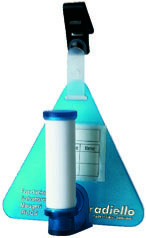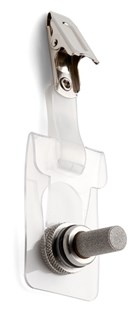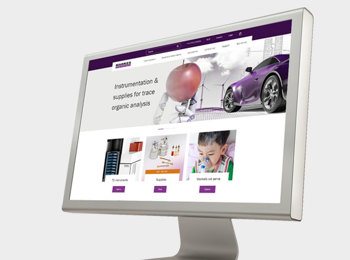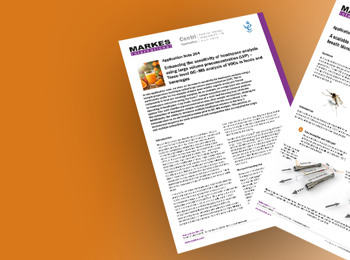
Monitoring the air we breathe with passive sampling
Markes International’s founder Elizabeth Woolfenden reflects on the hidden power of passive sampling, how it has evolved and its relevance in the modern world.
What is passive sampling?
There are lots of different sampling methods for monitoring smelly and/or toxic chemicals in the air – pumped sorbent tubes, canisters, even near-real-time monitoring with on-line analytical systems, but passive (or diffusive) sampling is one of the simplest and most reliable approaches, especially when you know which compounds you are looking for. There are passive samplers for organic vapours and others for inorganic gases, but all of them are relatively small and inexpensive, making them ideal for large-scale studies and for people to wear during human exposure tests.
The fundamental requirements of a good passive sampler are some sort of sorbent matrix to retain the compound of interest and a controlled diffusion barrier or gap separating the sorbent from the air you are monitoring. This creates a diffusion gradient going from atmospheric concentration at the surface of the sampler to zero concentration at the surface of the sorbent. As long as this remains true, each analyte will migrate down the diffusion gradient to the sorbent at a rate that is directly proportional to the atmospheric concentration and controlled by a constant ‘uptake rate’.
What can go wrong and what to look for in a reliable quantitative passive sampler
If the diffusion barrier in the sampler doesn’t slow down the rate of passive sampling enough, two important things can go wrong. Firstly, the atmospheric concentration can get depleted at the surface of the sampler, leading to inaccurate low results. Secondly, too much of the chemical can reach the surface of the sorbent too quickly, causing it to become saturated. When this happens, analytes soon start to back-diffuse out of the sorbent, causing the concentration at the surface of the sorbent to increase above zero. This too reduces the diffusion gradient, thus cutting the sampling rate and leading to incorrect low results.
Early badge-type passive samplers suffered badly from these problems and weren’t quantitative as a result. The issues were first properly addressed in the late 1970s by a committee of industrial and government scientists who came together under Working Group 5 of the UK Health and Safety Executive. They designed a sorbent-tube-form passive sampler for volatile organic compounds (VOCs) with a relatively long (15 mm) and narrow bore (I.D. 5 mm) air gap as a diffusion barrier. This prevented depletion at the sampling end of the tube and delayed the onset of back diffusion.1 The tube design was found to be ideal both for eight-hour workplace monitoring and for 1–2-week sampling of ambient and indoor air. It was also compatible with thermal desorption–gas chromatography–mass spectrometry (TD–GC–MS), which overcame the need for manual sample preparation with toxic solvents such as CS2 and provided up to 1000× more sensitivity.
The combination of diffusive tube and thermal desorption was an instant success, especially as the tubes could be used for both pumped or passive sampling and there are now more than six international standard methods around the world citing this type of passive sampler type with TD–GC–MS for quantitative air monitoring.2–10
Recent developments in passive sampling
Following this success, engineers and scientists were keen to develop alternative passive samplers that combined the robust quantitation of sorbent tubes with faster sampling rates, thereby enabling shorter-term (e.g., 8–24-hour) diffusive monitoring of pollutants at indoor and ambient air concentrations. The first of these ‘radial’ designs was the Radiello® sampler, introduced in the early 2000s by Istituti Clinici Scientifici Maugeri in Italy.
 Typical Radiello uptake rates are equivalent to around 20–30 mL/min for VOCs, much faster than the ~0.5 mL/min rate offered by sorbent tubes. This is great for short-term indoor or outdoor air studies but does result in rapid onset of back-diffusion, requiring uptake rates to be re-assessed for longer exposure periods to maintain quantitative results. These samplers have also proved very popular, offering the option of fast passive monitoring at ppb levels for the first time. They feature in many key international studies and are now available in an extended range including samplers for organics and inorganics, for TD and solvent extraction. The Radiello samplers can now be purchased from Markes International, too.
Typical Radiello uptake rates are equivalent to around 20–30 mL/min for VOCs, much faster than the ~0.5 mL/min rate offered by sorbent tubes. This is great for short-term indoor or outdoor air studies but does result in rapid onset of back-diffusion, requiring uptake rates to be re-assessed for longer exposure periods to maintain quantitative results. These samplers have also proved very popular, offering the option of fast passive monitoring at ppb levels for the first time. They feature in many key international studies and are now available in an extended range including samplers for organics and inorganics, for TD and solvent extraction. The Radiello samplers can now be purchased from Markes International, too.

Latterly, the technology of radial diffusive monitors has further improved with the introduction of Markes International’s POD (pocket diffusive sampler) device – a sampler combining the well-proven robust diffusion barrier characteristics of the axial sorbent tubes for uptake rate stability and the faster uptake rates typical of radial samplers.
Designed by scientists at the European Reference Laboratory for Air Pollution at JRC, Ispra, the porosity of the scintered metal body is carefully controlled to expose every square mm of sorbent surface within the POD to the same rate of diffusive ingress as the sorbent surface in the well-proven passive sorbent tube. This uniquely combines the exceptional stability of sorbent tube uptake rates (1–4 weeks) with faster sampling (~5 mL/min) and better sensitivity. Subsequent analysis is by TD–GC–MS.
Where is passive sampling used?
Passive sampling is used extensively for industrial hygiene (workplace air monitoring), fenceline monitoring of industrial sites, ambient and indoor air monitoring, human exposure assessments and as a complement to continuous on-line monitoring systems. A network of 100 or 200 samplers can be cost-effectively deployed across a city or region to map pollution hotspots while the convenience of these small and unobtrusive samplers means they can be used for human exposure measurements without causing wearers to moderate their behaviour.
Users include service laboratories in the occupational hygiene and environmental sectors, plus research labs, government agencies and industry.
For a list of relevant standard methods, including ISO, CEN, US EPA and ASTM, please see Markes International’s Application Note 003: National and international standard methods relating to speciated monitoring of vapour-phase organic chemicals in air.11
References
- R.H. Brown, J. Charlton and K.J. Saunders, American Industrial Hygiene Association Journal, 1981, 42: 865–869, https://www.tandfonline.com/doi/abs/10.1080/15298668191420828.
- ISO 16017-2:2003(en) Indoor, ambient and workplace air — Sampling and analysis of volatile organic compounds by sorbent tube/thermal desorption/capillary gas chromatography — Part 2: Diffusive sampling.
- EN 14412: Indoor air quality. Diffusive samplers for the determination of concentrations of gases and vapours. Guide for selection, use and maintenance.
- BS EN 14662-4:2005 Ambient air quality. Standard method for measurement of benzene concentrations Diffusive sampling followed by thermal desorption and gas chromatography.
- ASTM-D7758 Standard practice for passive soil gas sampling in the Vadose Zone for source identification, spatial variability assessment, monitoring, and vapor intrusion evaluations.
- ASTM D4597-03 Standard practice for sampling workplace atmospheres to collect gases or vapors with solid sorbent diffusive samplers.
- ASTM-D6306 Standard guide for placement and use of diffusive samplers for gaseous pollutants in indoor air.
- US EPA Method 325A – Volatile organic compounds from fugitive and area sources: Sampler deployment and VOC sample collection.
- US EPA Method 325B – Volatile organic compounds from fugitive and area sources: Sampler preparation and analysis
- MDHS 80: Volatile organic compounds in air. Laboratory method using diffusive solid sorbent tubes, thermal desorption and gas chromatography (August 1995).
- Markes International, Application Note 003: National and international standard methods relating to speciated monitoring of vapour-phase organic chemicals in air.


![Markes TD Brochure Hero3 Corepurple[2]](/media/zmscvqds/markes-td-brochure-hero3-corepurple-2.jpg?cc=0.55128205128205132,0,0,0&width=350&height=260&v=1d660d04edbcca0)






